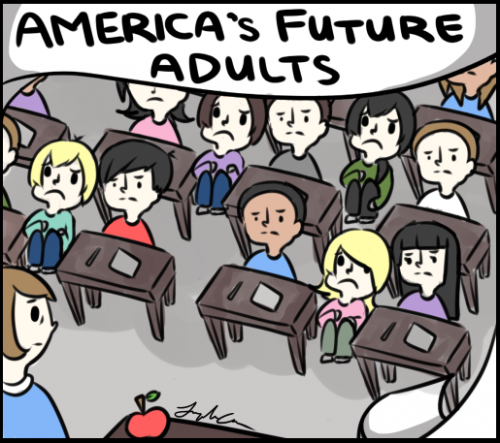No Nickels for Knowledge

Staff Writer
Nowadays, most students in Kansas are dealing with this situation: sharing one 36-people maximum occupancy classroom with over 50 students, lacking replacements for well-thumbed textbooks or teacher resources, but are still being asked to reach even higher academic standards or career readiness in the presence of these adverse conditions.
According to the New York Times, a series of educational budget cuts in Kansas was first issued in 2009. Benefiting mostly upper-income Kansas residents, Governor Sam Brownback proposed a $1.1 billion tax break that accelerated the cuts. The proposal was enacted in 2012 and it triggered significant program reductions which led to repercussions as parents filed and won a lawsuit in Gannon vs. State of Kansas.
However, rather than comply, Governor Brownback appealed to the court and the Kansas legislators also denied any court order for increased funding.
The outcome of the lawsuit could send waves through state capitals across the nation. The issues addressed will not only be focused on educational budget cuts, but also on deeper concerns about the political system. Ignoring a state Supreme Court order is a violation of law and a denial of the elected branches’ own responsibility and judicial independence. Their action is undermining the basic principles and structure of our democracy, as legislators are not even following requirements set by previous legislation.
Along with 11 states including New York, Florida and Texas, California allegedly provides inadequate and unfair school funding. According to the Center on Budget and Policy Priorities, California has slashed public education funding to 13.8 percent from what it was in 2008.
Instead of solving any problems, cutting the budget is actually bringing new problems. To help districts cope with the cuts, schools need to reduce school days by up to five days a year. The New York Times reported that most summer school programs for students from elementary through high school were also canceled due to budget cuts. According to the Los Angeles Times, some public school classes in Los Angeles are so crowded that students sit on the floor while teachers struggle to maintain quality and grade hundreds of papers. The cuts along with the tax break will also deepen the gap between higher-income students and the majority group.
At a time when students with the skills to master new technologies become extremely important to a country’s prosperity and also the global economy, this decline in state educational investment is cause for concern. In order to give every child the educational opportunity to meet his or her promise, and to strengthen and advance the core American value of equal opportunity, provisions for suitable school funding must be made because the government is responsible for the education for all children. Essential cuts on useless spending are necessary, but the cuts should not affect any teaching standard or the quality of education. More specifically, sufficient funding should allow the schools to hire enough faculty and prevent students from studying in overcrowded environments. Legislators must take the responsibility to provide and allocate adequate resource for education, for the young adults and for the country’s economic competitiveness.